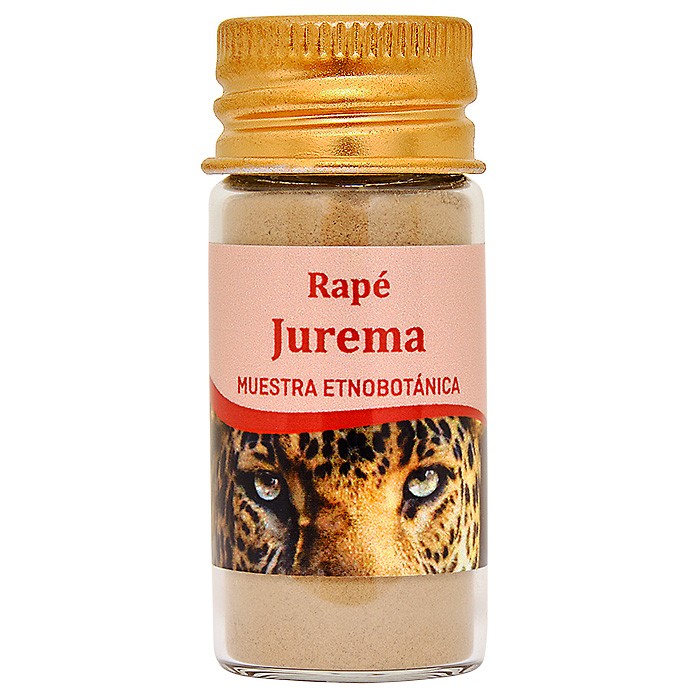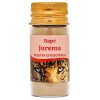Rapé Jurema
26,00€
Rapé Jurema contient un mélange de Mapacho de Sabia et Mapacho de Arapirca, des cendres de Tsunu et Jurema Preta.
Jurema Preta ou Mimosa Hostilis est une plante utilisée dans les cérémonies indigènes du nord-est du Brésil. Il pousse dans l’écosystème de savane du nord-est et appartient à la famille des acacias. C’est un véritable spectacle avec ses belles fleurs qui flottent au vent comme des panaches blancs.
Elle est également utilisée pour ses propriétés de régénérateur cellulaire, bactériostatique, antiseptique, analgésique, cicatrisante et régénérante.
Arbre Jurema
Taxonomie
Connue au Mexique sous le nom de Tepezcohuite, c’est la même plante qu’au Brésil est connue sous le nom de Jurema (Mimosa hostilis).
Les autres noms communs sont : Jurema preta, jurema negra, ajucá, espineiro (Brésil) ; tepescohuite (Mexique), cabrero, charbon de bois, carbonal.
C’est une espèce à feuilles caduques, qui fleurit et porte ses fruits pendant la période relativement sèche de l’année, lorsqu’elle n’a pas de feuillage.
C’est un maquis épineux très abondant au Mexique (Basse Californie, Oaxaca et côte du Chiapas), en Amérique centrale, dans les plaines du Venezuela et dans les plaines arides de l’est du Brésil : Pernambuco, Minas Gerais et Bahia, où d’autres sont aussi appelés « jurema ». Espèces de mimosa comme le jurema blanc (Mimosa verrucosa).
Au Mexique, on l’appelle aussi arbre à peau, car son écorce possède d’importantes propriétés antimicrobiennes, analgésiques et régénératrices cellulaires.
Mimosa hostilis a des fleurs blanches, tandis que les fleurs de Mimosa verrucosa sont roses. Mimosa hostilis n’a jamais de fleurs jaunes ou roses.
Histoire
Il a été récemment reconnu que le Mimosa tenuiflora mexicain, décrit botaniquement en 1810, est la même espèce que le Mimosa hostilis brésilien.
Les Mayas du Mexique à l’époque préhispanique l’appelaient « Tepezcohuite ». Selon le Dictionnaire des aztèques de Cabrera (1975), le mot Tepezcohuite vient des mots nahuatl tepetl (colline) et cuahuitl (arbre), « arbre de la colline ».
Le nom « arbre à peau » est également devenu populaire au Mexique, qui, selon Genis (1987), vient du mot nahuatl tepexohuitztli.
De plus, on l’appelle tepuscuahuitl, ce qui signifie « arbre de fer ou de métal » en allusion à la dureté de son bois.
L’écorce de racine contient entre 0,25 % et 4,5 % de DMT (N,N-diméthyltryptamine) du poids sec de son écorce de racine.
L’écorce du tronc est vendue sur les marchés du Mexique pour ses applications en médecine populaire. En revanche, les indigènes du Brésil qui élaborent le « vinho da jurema » n’utilisent que l’écorce de la racine.
L’efficacité du tepezcohuite a pu être mise à l’épreuve par deux événements tragiques survenus au Mexique dans les années 80 et qui ont massivement affecté la population.
En novembre 1984, il a été utilisé pour soigner des centaines de blessés souffrant de graves brûlures cutanées causées par une malheureuse explosion de gaz.
Deuxièmement, en 1985, il a été utilisé pour soigner les blessures des victimes du tremblement de terre.
Dans les deux cas, il a été utilisé massivement avec des résultats très satisfaisants dans la reconstruction de l’épiderme, ainsi qu’en repigmentation.
Mayas
Considéré comme un arbre sacré, le Jurema était utilisé par les Mayas comme remède contre les maladies de la peau, comme régénérateur cellulaire et pour soigner les blessures ; Il était communément connu comme « l’arbre dont la coquille est transformée en poudre qui guérit les blessures ».
Ils utilisaient le tepezcohuite en appliquant la poudre de son écorce sur les plaies et surtout les brûlures, pour calmer les douleurs et accélérer grandement leur cicatrisation, empêchant même l’apparition de cicatrices.
Boisson Jurema
Le Jurema est un arbuste largement utilisé comme analogue de l’ayahuasca, à partir de la racine duquel on obtient la « boisson jurema » ou « vinho da jurema », utilisée dans les rituels et les cérémonies.
Sa préparation consiste généralement à faire macérer ou infuser les feuilles dans de l’eau ou de l’alcool.
Jonathan Ott a vérifié en 1998 qu’après vingt minutes de consommation de vin de Jurema, un effet visionnaire de type DMT est perceptible pendant environ deux heures. Cependant, on sait que la Diméthyl Tryptamine (D.M.T.) est inactive par voie orale.
Il manque également de substances qui inhibent l’enzyme humaine Mono Amino Oxidase (IMAO). Pour toutes ces raisons, on suppose que Jurema doit contenir un certain type de tryptamine oralement active, encore à découvrir.
Boisson Juremahusca
Dans les années 1990, des chercheurs spécialisés dans les expériences psychoactives ont créé le Juremahusca, une boisson analogue à l’Ayahuasca composée d’un mélange de graines de Jurema et de rue syrienne (Peganum harmala), originaire d’Afrique du Nord.
L’écorce de la racine de jurema contient généralement de 0,5 à 1 % de D.M.T, tandis que les feuilles de chakruna (Psychotria viridis) contiennent de 0 à 0,20 % en moyenne de DMT.
Dans certaines écorces de racines de Mimosa hostilis mexicana, une teneur en DMT beaucoup plus élevée a été trouvée, entre 1 % et 11 % (Ott 2001). L’écorce du tronc contient des niveaux beaucoup plus faibles de DMT, tout comme les feuilles.
Des précautions doivent être prises avec les feuilles et le tronc, car ils peuvent contenir de la mimosine, une substance toxique.


